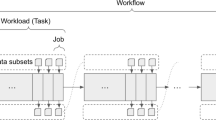Abstract
Modern scientific experiments acquire large amounts of data that must be analyzed in subtle and complicated ways to extract the best results. The Laser Interferometer Gravitational Wave Observatory (LIGO) is an ambitious effort to detect gravitational waves produced by violent events in the universe, such as the collision of two black holes or the explosion of supernovae [37,258]. The experiment records approximately 1 TB of data per day, which is analyzed by scientists in a collaboration that spans four continents. LIGO and distributed computing have grown up side by side over the past decade, and the analysis strategies adopted by LIGO scientists have been strongly influenced by the increasing power of tools to manage distributed computing resources and the workflows to run on them. In this chapter, we use LIGO as an application case study in workflow design and implementation. The software architecture outlined here has been used with great efficacy to analyze LIGO data [2–5] using dedicated computing facilities operated by the LIGO Scientific Collaboration, the LIGO Data Grid. It is just the first step, however. Workflow design and implementation lies at the interface between computing and traditional scientific activities. In the conclusion, we outline a few directions for future development and provide some long-term vision for applications related to gravitational wave data analysis.
Access this chapter
Tax calculation will be finalised at checkout
Purchases are for personal use only
Preview
Unable to display preview. Download preview PDF.
Similar content being viewed by others
Author information
Authors and Affiliations
Editor information
Editors and Affiliations
Rights and permissions
Copyright information
© 2007 Springer-Verlag London Limited
About this chapter
Cite this chapter
Brown, D.A., Brady, P.R., Dietz, A., Cao, J., Johnson, B., McNabb, J. (2007). A Case Study on the Use of Workflow Technologies for Scientific Analysis: Gravitational Wave Data Analysis. In: Taylor, I.J., Deelman, E., Gannon, D.B., Shields, M. (eds) Workflows for e-Science. Springer, London. https://doi.org/10.1007/978-1-84628-757-2_4
Download citation
DOI: https://doi.org/10.1007/978-1-84628-757-2_4
Publisher Name: Springer, London
Print ISBN: 978-1-84628-519-6
Online ISBN: 978-1-84628-757-2
eBook Packages: Computer ScienceComputer Science (R0)




